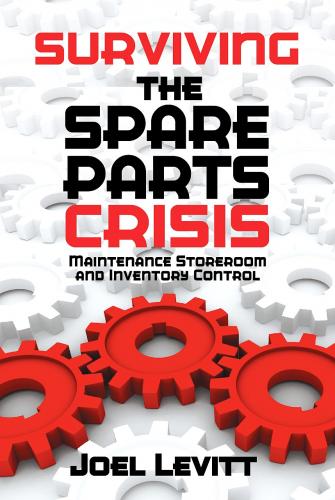Finally, Mike Brown, President of New Standard Institute, was instrumental in training me on issues involving production and process industry spare parts and letting me present his Inventory Management class.
Finally I would be nowhere without the team at Industrial Press, with Robert Weinstein, my intrepid editor (without whose expertise the book wouldn’t have been so understandable); Janet Romano, the production and art director who makes it all look good and somehow puts up with the images I provide; and, last but not least, Judy Bass the acquisitions editor who saw something in this work and pushed it through several hurdles.
Joel Levitt2016
ABOUT THE AUTHOR
Joel D. Levitt,CRL, CPMM,Prosci Certified Change Management Practitioner
Mr. Levitt is Director of Reliability Projects for Reliabilityweb.com. Reliabilityweb.com is dedicated to discovering and delivering effective approaches that make maintenance professionals, reliability leaders, and asset managers safer and more successful. Joel Levitt’s roles include senior teacher, course designer, and advisor.
Previously, Mr. Levitt was Director of International Projects for Life Cycle Engineering, a group of reliability engineers and maintenance consultants in a wide variety of industries. He has worked in highly regulated environments such as the Food and Drug Administration (FDA) and the Department of Transportation (DOT). He has also worked in unregulated, union, and non-union environments.
Prior to that, Mr. Levitt was for many years the President of Springfield Resources Company (SRC) as a leading maintenance trainer. He has trained over 17,000 maintenance professionals from 25 countries and has conducted over 550 sessions. Notably, 98% of the participants rated the training very good or excellent.
Prior to his work at SRC, Mr. Levitt was a Senior Consultant at Computer Cost Control Corp. He helped its president design and market computerized maintenance management systems to organizations such as FedEx, United Airlines, JFK Airport, and SuperValu Stores.
He also designed, installed, and serviced a complete automation with rack control, accounting, and inventory control for one of BP’s 30,000-barrel/day oil terminals. He designed railroad fuel security and accounting systems that were adopted as the recommended standard by the Association of American Railroads (AAR). Mr. Levitt also owns and manages rental properties in Philadelphia, Florida, and New Jersey.
Mr. Levitt has written nine maintenance-oriented books, one general business book on meetings, and one book on psychological issues.
CHAPTER 1
WHAT ARE WE REALLY DOING?
MISSION
Have the right part available in time to support the maintenance function while using the least organizational resources.
Major Objectives to Support the Mission
• Provide the parts needed quickly for maintenance and others
• Minimize use of cash
Mini-Objectives to Support the Major Objectives and Mission
• Know where everything is
• Know what is being used and what is not being used
• Keep track of quantities
• Protect parts from spoilage, theft, and damage
• Report facts to management
PARTS ARE THE POINTER TO THE MAINTENANCE PROBLEMS
Parts consume 40% to 70% of every maintenance dollar. Because most maintenance jobs require some parts, reducing part usage will automatically reduce labor.
Analysis of part use is fundamental to maintenance control. Track your expenditures for part usage to uncover areas where your time would be well invested. Continuous improvement will follow from this investment. Balance the following:
| Minimize the dollar value of stores inventory | = | Provide all materials required to keep a facility running |
MANAGEMENT OF CHANGE IN THE STORES ORGANIZATION
You can rethink how you organize the storeroom when changing an existing storeroom operation or establishing a new storeroom for a new factory or facility. It is essential that normal stores operations continue while the reorganization takes place.
Any major change in the warehouse will concern the major stakeholders. These stakeholders include:
Primary stakeholders
• Existing stores manager
• Storeroom team members
Outside stakeholders
• Operations team and managers
• Maintenance manager
• Individual maintenance worker
• Maintenance planner / scheduler
• Finance comptroller / CFO
• Purchasing agent / buyer
• Auditor
The start of any storeroom improvement effort begins with these questions:
• What is the effort’s mission and what we are trying to change?
• Is there an aspect of the operation that is “broken”?
• What investment is needed for fixed assets, furniture and fixtures, picking systems, mobile equipment, maintenance inventory, other machinery, and tools?
• What return on investment is required?
• Who will manage the reorganization?
• Are there physical changes needed and will the storeroom be relocated?
• How long will the improvement take?
The second component of storeroom improvement is establishing a change team. Members can include the existing stores personnel, the maintenance manager, engineering, purchasing, and finance.
ADKAR®
Prosci® is a business management consultant that helps organizations manage change. Their change management model, ADKAR®, incorporates five steps to successfully manage any corporate change: awareness, desire, knowledge, ability, and reinforcement.
A: Awareness The first step is to make everyone aware of the change. This communication should come from an officer of the organization. That officer should outline the scope of the change, the reason for the change, and the benefit of the change for everyone.
D: Desire Within the various change management groups, local supervisors have to build a desire to change. To build desire, the local supervisor might appeal to some motivators such as pride, job satisfaction, or challenge. The change might include elements that provide a better service, a more interesting job, work simplification, better competition, or some way of creating more opportunities.
K: Knowledge People won’t change if they don’t understand what to do. This phase provides training, including some hands-on activities. Your goal is to raise competence in both skills and knowledge, along with a shift in attitude.
A: Ability Your employees need the ability to make the changes they need to.
